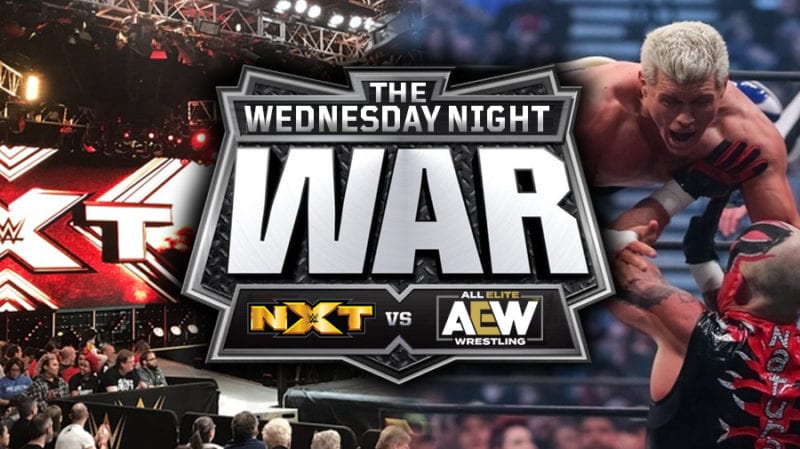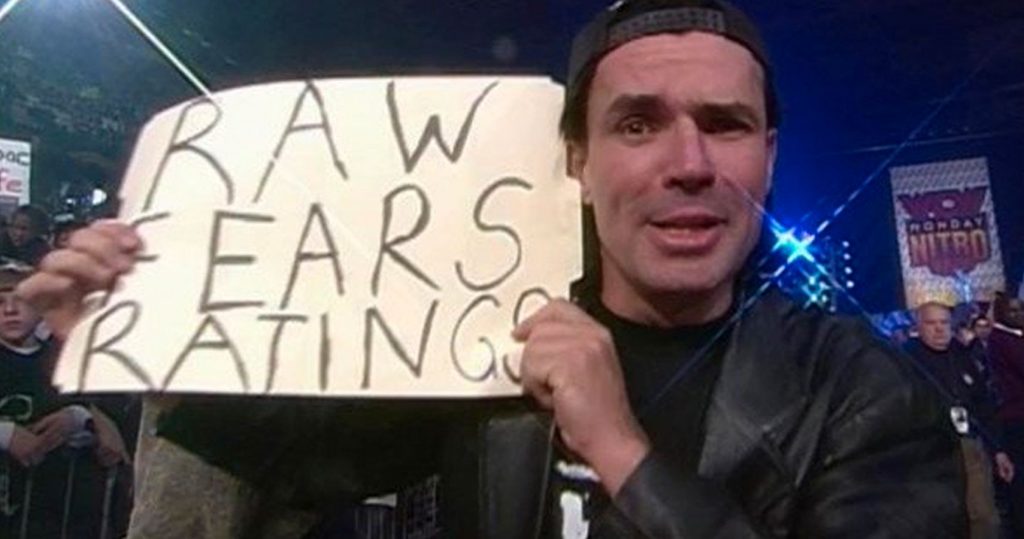The Demos Will Get You: Why AEW Needs to Forget About Ratings
When it comes to wrestling and Demos, the only ones I’m really interested in are Ax and Smash – the bona fide ass-kicking, Jason Vorhees hockey mask wearing tag team of Demolition. In their theme tune, a stomping great big 80s rock gem called Pain and Destruction, lyricist Rick Derringer sings “The Demos will get you.” And they would. They were great.
Cut to 2020, and “the Demos” are once again a hot topic in the world of pro wrestling – but sadly there’s neither an Ax or a Smash in sight. Instead, we have profiling of the general TV viewing public, broken down by age, by gender, by ethnicity, by income level, by geographical location, by highest education level attained… you get the idea. About as corporate and cold as you can get. It’s a world away from the team that would, by their own admission, kick your teeth down your stinking throat.
Now, the performance of TV shows – specifically two head-to-head wrestling TV shows – have yet again become something of a contentious subject not only amongst wrestling fans, but also amongst the wrestlers themselves.
For reasons that I’ll come on to shortly, I don’t like it one bit.
If you watch the AEW side of the recently dubbed Wednesday night war, or indeed follow the likes of Chris Jericho on social media, you’ll have seen and heard reference to how AEW is beating head-to-head WWE rival NXT in key ratings demographics. Jericho has even dubbed himself the “Demo God,” in a move that’s half serious, half tongue in cheek internet trolling. Oh, and naturally there’s a t-shirt that bears the slogan “Demo God 18:49”, because of course there is.
But does any of it really matter to the average fan? Should it? And is there actually an argument that by shining a light on your ratings that you’re putting your own success at risk?
How ratings work

All wrestling promotions need to make money – they’re businesses after all. For those that make it onto television, the easiest way to make that money and continue to secure their spot on TV is through advertising sales. There was, according to Price Waterhouse Cooper, around $81billion spent on TV advertising last year so, in the grand scheme of things, it’s good to be getting a slice of that action. And don’t get me wrong, here: I’m not suggesting that wrestling promotions should be altruistic, non-profit organisations – I like the big budget spectacle of wrestling, and have ploughed plenty of cash into the pockets of many wrestling promotions big and small over the years. Clearly, ratings matter.
At their most basic level, they tell advertisers what percentage of households with a TV set watched a show. The more viewers (ideally the right type of viewers), the higher the advertising revenue and the better position the promotion will be in.
The 18:49 bracket is particularly rich pickings for advertisers because, the theory goes, that this age range are more likely to have disposable income that might get spent buying their stuff. It’s always been this way, and probably always will.
To figure these ratings out, the leading US ratings provider Nielsen samples the viewing habits of around 100,000 people (or around 0.00003% of the population) on a regular basis. These 100,000 or so people spread across around 40,000 homes allow Nielsen to grab the data of what they’re watching, when they’re watching it and for how long, and send it for analysis via a literal little black box in their living room via an internet connection. Nielsen know who is in each household too, so can further build up a picture of exactly who is tuning in.
In some instances, for local TV ratings, the company even relies on participants filling out a paper-based diary of their viewing habits – a bit of an old school throwback to when the company assessed how many people would listen to radio in the 1930s – but expect this to be phased out entirely before too long. Much more up to date are the platforms that Nielsen analyses – they’ll log not just TV viewing, but content that’s consumed on computers, consoles, tablets and phones. With the growth of video on demand and consumers watching their content a time of their choosing, a full 7 days worth of data goes into determining the final ratings for any particular show too. It’s pretty clever stuff and when it’s used in the boardroom, it’s absolutely relevant. When it’s used to leverage more TV time for my favourite promotion, then that’s great. When my favourite company gets a nice big cash injection that keeps them running so I can continue to enjoy what they do, then I’m happy. More power to them. Now here comes the “but”…
But – when that data makes its way out of the boardroom and onto my TV, it reminds me what I am to wrestling promotions – I’m a customer. I’m a consumer. I’m a statistic on a spreadsheet. I’m a marketing persona. I’m all of those things first, then a fan last. It overtly reminds me I’m part of an audience profile, a cog in the money making machine, when I just wanna be a wrestling fan. And that kinda sucks.
If you don’t learn from history…
Now the real kicker of all of this is that it’s not the first time that wrestling has gotten obsessed with TV ratings as part of an angle or a storyline. You see, there’s some interesting parallels – and admittedly some screamingly obvious differences – that can be drawn between the current trend for using ratings wins as leverage over your competition and the last time this happened in the world of wrestling. After all, wrestling hasn’t been this overtly self-obsessed with ratings since the late 90s, when WCW triggered the original wrestling ratings rumble (The Monday Night War) by placing their flagship live wrestling show Monday Nitro head-to-head against the WWF’s Monday Night Raw.
What happened back then, following some big money acquisitions on the part of WCW, was the start of an often quoted 83-week run that saw Monday Nitro beat Raw in TV ratings. On Monday, 20th May 1996, for the historians amongst you, WCW main-evented that show with a World Heavyweight Title Match which saw their champ The Giant (now of course known as The Big Show) defeating Arn Anderson. This went up against the Raw main event where my fellow countryman the late, great British Bulldog Davey Boy Smith fought to a no-contest with Jake ‘The Snake’ Roberts.
In the intervening months and years, this seemingly unstoppable streak became, quite understandably, a feather in the cap for Eric Bischoff and co. over at WCW – and a stick to beat the WWF with. Playful jabs were fired at McMahon about how the live WCW show was consistently outperforming the predominantly taped episodes of Raw. Fans started carrying signs at WCW shows proclaiming that “Vince fears ratings” or “Bischoff = ratings”. It was the first time that we, the fans, would weaponise the TV ratings that our favourite shows would hold over whomever the other guy was. In the playground that was wrestling, it didn’t matter if our dad was better than your dad: it mattered that our dad got better ratings.

Raw wouldn’t win in the TV ratings until Monday 13th April 1998 – nearly two years later – where the main event that finally broke that drought saw Stone Cold Steve Austin defend the WWF Championship against Vince McMahon (ending in a no contest). It outdrew the Nitro main event of Kevin Nash’s DQ win over WCW World Heavyweight champ Sting, and delivered the WWF a ratings win. And what a sweet win it must have been.
The tide began to turn. But, as is often the case with commonly held truths, it’s a little more complicated than that.
Nitro enjoyed at least four weeks unopposed by Raw during this period, with the latter bumped off air for events like the US Open Tennis championships on more than one occasion. There’s a further two weeks of data missing where the ratings for Raw aren’t available, and a third week where the same problem occurs for Nitro too. But who are we to pick apart the details here? The short version is that, for a very long time, WCW kicked Raw ass in TV ratings.
Of course, Vince still went on to buy WCW.
Which is perhaps what makes the parading of demographic data, TV ratings wins and the like all the more worrying. Competition really is good for wrestling (I personally want AEW to do brilliantly) but should you really echo a victory speech that was so painfully premature that the whole company that it was celebrating ended up strip-mined for talent and TV content, and owned by the guy it once crushed in the ratings wars? “Those who do not remember the past,” as George Santayana wrote, “are doomed to repeat it.” Jericho should remember. Jericho was actually there.
Was the obsession with a ratings streak the only contributing factor that brought down WCW? Of course not. Was it part of it? Absolutely. Does it make a long-time fan of wrestling like me a little nervous that the standard bearers of AEW are emulating the side that won the Monday Night Battles, but finally lost the Monday Night War? 100%.
Sure, Nitro and Raw were the WCW and WWE flagship TV shows. You could truly take the temperature of this battle, where both sides were always firing their biggest guns in a like-for-like competition. Dynamite currently stands as AEWs marquee show – their Nitro, if you will – but even the most stalwart NXT fan couldn’t argue that from any perspective – be it budget, roster depth, global brand recognition or star power – that the same can be said of the black and gold brand. Sure, the counter argument is that AEW is so new compared to WWE that beating any of their content is a massive win – and I’m fine with that point of view too, but to be blunt, if you want to be taken seriously and not get special treatment for being the new guy, it’s more akin to Nitro beating Wrestling Challenge or Heat than beating Raw.
Back then, WCW became self-referential. The WWF carried on. WCW gloated over and flaunted its wins. The WWF carried on. WCW took what was of interest to shareholders, advertisers and marketing teams in expensive suits and told the fans they should care too. The WWF carried on and then eventually, one day, WCW just… didn’t.
The new “Vince fears ratings” is “Demo God: 18:49” – only now we see it in crystal HD. The Vince fears ratings sign maker isn’t a WCW fan any more, but an AEW one. Eric doesn’t = ratings: Jericho does. Vince meanwhile… well, Vince is still Vince.
If the team steering the AEW ship is as wise as I think they are, they should maybe be a little more reluctant to echo the past so closely – because it didn’t work out so well for the other guys last time around. Fight with all you’ve got for ratings. Earn the wins where you can. But maybe, just maybe, leave the ratings in the boardroom instead.
For me, I’m just going to continue to enjoy the content I enjoy – AEW, WWE, NJPW and more. Now if you’ll excuse me, there’s a match between the Hart Foundation and Demolition I’ve been meaning to re-watch. It’s from Summerslam 1990. 30 years on, I can tell you every move of that match, who wins and how. I’ve got zero idea what kind of buy rate or ratings it would have drawn – I don’t need to. Even now, those Demos with a capital D still really do get me. The other demos just don’t.
